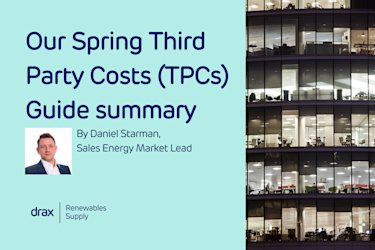Managing volatility in Contracts for Difference (CfD)
This article was first featured in the Major Energy Users Council (MEUC) Summer 2024 issue of Buying and Using Utilities Magazine.
The CfD is the main policy mechanism for supporting investment in low carbon generation in GB. Under the CfD, generators receive a strike price for 15 years based on a competitive tender process. This strike price (inflated to money of the day terms) is compared to a market reference price in the wholesale market. Where the wholesale market price is lower, suppliers (and ultimately, consumers) must top-up the revenues to the strike price. Alternatively, generators pay back the surplus if the market reference price goes above the strike price.
The payments, and repayments, paid and received by the Low Carbon Contracts Company (LCCC) for the CfD scheme are passed on to consumers’ electricity bills. However, the LCCC is obliged to forecast – each quarter – the total level of payments from consumers. And to smooth out this volatility, it sets an Interim Levy Rate (ILR) alongside a reserve amount. The LCCC reconciles the costs to a daily out-turn levy rate at the end of the quarter.

Recent movements
During the 2023/24 winter, there were substantial reductions in wholesale prices due to high levels of gas storage, a lack of prolonged cold spells, high renewable generation and weak demand. This has driven reciprocal volatility in the CfD scheme.
The first of these movements was a within-period adjustment announced on 26 January 2024. From 25 February, the ILR rose to £10.748/MWh from £4.540/MWh, more than doubling within the month. The LCCC attributed this entirely to falling wholesale prices over the quarter. This meant there was a chance it would have insufficient funds to make all the payments due to generators.
The LCCC also announced – on 15 February – an increase to costs from 1 April. The ILR jumped up from £7.755/MWh to £11.522/MWh. The LCCC said this was in response to an extra 1.5GW of offshore wind capacity commencing its CfD contract and continued bearish trends in forward power pricing through January.

Future trends
CfD-backed generation is increasing substantially. According to the LCCC’s Forecast Dashboard, CfD-supported generation is likely to grow from ~30TWh in 2023-24 to 120TWh in 2030-31. This is based only on existing contracts already awarded under previous allocation rounds. The Weighted Average Strike Price (WASP) of these contracts is £89/MWh (2022 real prices).
Based on this data, let’s undertake a quick thought experiment. The following graph outlines CfD plus wholesale price costs under different environments and various levels of demand.

We can see the £/MWh cost vary substantially depending on:
- The wholesale reference price, because of the direct relationship between the two costs.
- The eligible demand over which the costs are spread – this will play a significant role in determining the combined wholesale and CfD cost. As the amount of generation under the scheme approaches the level of demand, the cost curve is flatter
o The 200TWh demand scenario experiences a cost increase of £0.45/MWh for every £1/MWh increase in wholesale price.
o At 350TWh, it experiences a £0.68/MWh increase for every £1/MWh in wholesale price.
*For reference, National Grid’s Future Energy Scenarios - Leading the Way estimates 310TWh of system demand by 2030
The higher the amount of intermittent renewable generation, the greater the chances of a negatively priced period. In such scenarios, the majority of CfD generation will not receive support, hence the dramatic reduction in costs below £0/MWh.
We should point out that this is a gross simplification. These dynamics will be occurring on a half-hourly basis – annual statistics are a generalisation. There are a range of strike prices, and the WASP will vary depending on the generation mix, which will need to be inflated to money of the day terms. This will likely increase it by 20%+ due to the cumulative nature of the Consumer Prices Index (CPI). There’ll also be a different impact from baseload CfD generation, which is indexed to seasonal rather than day-ahead prices.
When supported generation starts to approximate demand, we begin to see a near-flat line effect – the total cost is set by the WASP and doesn’t vary significantly with wholesale price. However, once more, this would be dependent on day-ahead wholesale prices clearing at or above £0/MWh.
Managing CfD risk
There are several ways to manage the volatility inherent in CfDs.
You could fix the CfD cost depending on your organisation’s annual consumption and your supplier’s product suite and appetite to manage the risk. While this entails minimum risk, asking the supplier to price in the risk inevitably comes with a risk premium. As CfD capacity grows, this is likely to be a non-tenable option.
Another solution would involve passing through the costs at the Interim Levy Rate. However, you potentially face large quarterly and within-period swings depending on weather movements, prevailing wholesale prices and so on. Going forward, setting the ILR would be about correctly forecasting prevailing wind speeds and day-ahead wholesale prices. The two would become increasingly correlated, making forecasting challenging.
Alternatively, managing the CfD and the wholesale price co-optimally, you could reduce volatility by taking wholesale volume to the day-ahead stage. By aggregating the two charging components together, your hedging strategy more effectively manages the overall volatility of the costs. Separately, due to the different reference prices for baseload technologies, a smaller volume should be traded at season ahead.
This third option is the solution we’ve developed at Drax Energy Solutions. And we’re working collaboratively with some of our large I&C customers to help implement it as part of their risk management strategy.
To discuss this in more detail, get in touch.
Get in touch


